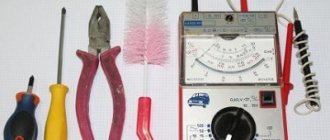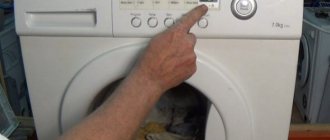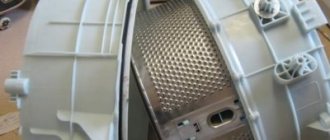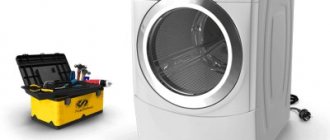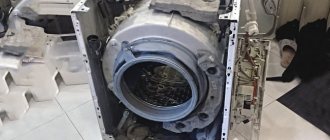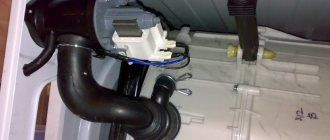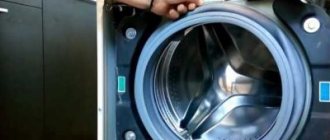Automatic washing machines used in everyday life have their own design features. The general principle of operation of household machines with front or vertical loading is almost the same.
The body of the automatic machine consists of a metal frame in which all components and assemblies are located, the main one being the heating element for the washing machine. In different models, in addition to the main parts, there are also other additional components.
The owner of the equipment needs to understand how it works and the principle of its operation. This is necessary in order to understand the breakdown of the car, know what went wrong and how to cope with the repair on your own.
The design and principle of operation of the heating element
With the help of a heating element, water is heated. For certain modes, washing only in cool water is provided; heating elements are not used there.
At high temperatures, the organic substances in the washing powder interact best with soiled laundry, making it perfectly clean.
The heating element looks like a curved tube with a metal wire inside through which electric current passes. This thin conductor has high resistance and has the potential to heat up. The heating process occurs without destruction and can reach high temperatures. The space from the wire to the walls of the tube is filled with a dielectric that is resistant to temperature increases.
The main units of a tubular heating element are:
- sealed outer metal tube;
- power connection terminals;
- heating coil;
- heat-conducting insulator (located inside);
- grounding terminal, screw-in bolt with nut;
- rubber retainer;
- pressure plate;
- insulators for external power terminals.
A thermoelectric heater converts electrical energy into thermal energy, causing the water to heat up. The heating element freely heats the water to the set temperature; in some models of washing machines it is involved in drying. Many elements have a temperature sensor that can be installed separately in the tank.
When you turn on the washing machine and set any program, the control unit delivers supply voltage to the heating element, the heating element heats up itself and, accordingly, warms up the water. After the temperature sensor determines whether the set temperature has been reached, the control unit will turn off the heating element, and in the future the water will stop heating.
The power of the heating element can reach 2200 W; the stronger the thermoelectric heater, the faster the water in the washing machine will heat up. With powerful heating elements, peak washing productivity is achieved faster.
Heating elements have good protection properties; they almost do not respond to different voltage supplies. Voltage changes may occur in the supply network, but this does not in any way affect the conductive thread inside the heating element. Therefore, the period of use of a thermoelectric heater is quite long.
Types of heaters for home
Water, steam and air heating systems are used to heat residential premises. Heating devices are used as additional heat generators:
- convectors;
- fan heaters;
- oil radiators;
- infrared heaters;
- heat guns and curtains.
But perhaps the most respectable device for additional heating of a home is an electric fireplace. You can choose the type of decorative fireplace that is suitable for your interior on the Vestakamin online store website here. The fire in modern electric fireplaces looks like real fireplaces. Some models provide a function - the sound of crackling wood, creating the illusion of a flame.
Reasons why heating elements fail
The first reason is a manufacturing defect. Such a breakdown is rare, but it does occur. When purchasing even a new washing machine, there is a risk of purchasing defective components.
The second problem is scale, which settles on the electric heater and impairs the operation of the heating element. Once the metal body of the heater is covered with scale, the thermal conductivity decreases. Heat cannot be completely transferred to water, and the heating element overheats. Having received more heat than needed, the heating element fails. Scale actively forms when the temperature reaches more than 60 degrees; washing at a lower temperature is considered optimal.
Scale also promotes the formation of corrosion, which alters the metal shell. Having lost its tightness, the heating element becomes unprotected from external influences, and there is a risk of fires and short circuits. To avoid this type of breakdown, it is recommended to clean the inside of the machine with special means every few months.
One of the reasons that worsens the performance of the heating element is the use of unsuccessful detergents. The use of hand washing powder or its excess for one wash has an effect on the heating element and envelops it with a film. Therefore, it is better to use special anti-scale products.
Another reason for overheating, which is associated with the contact of various solid objects, skeins of wire, thread, and small pieces of fabric from laundry on the heating element.
Before washing, be sure to check the pockets of clothes placed in the machine and remove all unnecessary items.
Other reasons for failure of the heating element of a washing machine are voltage surges, especially for houses in the private sector. In bad weather and a thunderstorm, it is better to turn off the power to the washing machine. If overheated for this reason, the heating element will look like new in appearance. There will be no visible signs of overheating or scale, but the heating element will not work.
There are times when the heating element turns on to heat water that has not entered the tank of the machine, and the heating element burns out. If a fuse is provided in the heating element pipe, then the damaged part appears without external damage. If there is no fuse, then an indicator of overheating of the heating element due to the lack of water will be the dark color of the metal tube, in some places peeling scale from elevated temperature conditions.
The new heating element can be installed in washing equipment after preventing the lack of water in the tank.
Heating elements may have the following types of faults:
- Heating element rupture. With such a problem, the thread burns out, the electrical circuit breaks, and the heating element stops working. Such a malfunction entails a complete replacement of the part.
- Current leakage, short circuit. Here the insulating layer of the heating element changes and a current appears on the body of the machine. With this malfunction, the part also changes.
- As a result of the formation of a layer of scale, the heating element burns out completely, swells and is a consequence of electric current leakage. The surface of the heating element can be cleaned with special means or using citric acid.
Failure of the heating element occurs for a number of reasons, but you can try to avoid it in advance:
- The cause of hard water can be eliminated by installing filters that make it soft and thereby prolong the operation of heating elements. Preventative work to clean the heating element will also not be superfluous.
- Low mains voltage leads to an increase in current strength, and the core of the heating element may burn out. In this case, a voltage stabilizer is installed and the cause of its damage is eliminated.
- The temperature controller fails and does not send a timely signal about its change. As a result, the heating element overheats. If the regulator breaks down, it is unlikely that the heating element will turn off at the right time. If a problem is detected in time, it can be avoided in a timely manner.
Self-check of the heating element’s performance
Various malfunctions are possible if the water in the MAS is not heated. Most likely, the heating element, which is the heating element, has failed. To ensure this, you need to pay attention to the following problems:
- When washing things, the water remains cool and does not reach the set temperature.
- The wash ends quickly after 8-10 minutes, but water flows into the tank.
- After starting the car, electrical plugs are knocked out.
- At the beginning of the streak, a burning smell occurs.
- The cleanliness of the linen is not the same as before.
- When you touch the washing machine, you feel an electric shock.
If at least one of these signs is observed, then the heating element in the machine needs to be changed as quickly as possible. You can replace the part yourself or negotiate with a technician at a service workshop.
For many types of washing equipment, the heating element is located behind. In this case, you need to remove the machine panel by unscrewing the screws. If the heating element is located in the front, then the actions are the same, only the heating element is located on the front side.
You need to look for the heating part in the lower location of the tank and try to disconnect it from the wires. In order not to lose track of the connections, you need to photograph the contacts and only then remove them. When taking out the heating element, you need to unscrew the nut located in the middle of the heating element. The visible bolt should go inside; to do this, you need to press on the end of the bolt.
When taking out the heating element, you need to pry it off with some object, for example, a screwdriver. After removal, it is easy to check its functionality. For this purpose, a visual inspection method is used. You just need to carefully examine the part. If dark marks in the form of small spots are noticeable on the heating element, then most likely the housing of the heating element is broken. Traces of scale will also be visible visually.
By carefully studying the heating element, you can understand the method of fixing it on the tank and understand how sealing is carried out. After the nut is tightened, the rubber fastening mechanism becomes wider. Due to expansion, the heater is securely held in place and does not allow water to get inside the washing machine.
The heating element can only be removed after twisting the nut and pressing on the stud to deepen it inward. You must use a screwdriver to remove the heating element carefully, without breaking the tank; in some models of machines it is very fragile, and there is a possibility of damaging it.
When returning the heating part to its previous recess, you must carefully monitor that it fits into the required opening in the lower part of the tank. If the heating element is moved upward, it may touch the drum; the problem will be revealed during the spinning process.
How to find a part
In different brands of washing machines, the heating element is located differently - in Indesit and Ariston it is at the back, but in Bosch and Siemens it is more convenient to reach from the front. If you have a wiring diagram for the heating element of the washing machine, it will be easier to proceed.
But if you have nothing to start from, then find its location yourself:
- Inspect the back panel. If the back cover of the SM is quite large, then the heating element is most likely located behind it.
- Lay the washer on its side and look into it from the bottom to find the heater.
- A simple and effective way: remove the back cover. Even if you don’t find a heating element behind it, putting the panel in place won’t be difficult.
Attention! You can also arm yourself with a flashlight and illuminate the drum from the inside, but you need patience and good eyesight to understand the exact location of the heater.
If the heating element is found, it’s time to figure out how to check the heating element with a tester. Before ringing the heating element, it is not necessary to remove it.
Expert advice on replacing heating elements in washing equipment
Accurate confirmation of the reasons for the failure of the heating element occurs only after disassembling the equipment and testing the heating element with a multimeter.
To take measurements, the machine must be disassembled to gain access to the electric heater. The heating element does not always need to be changed; the wires on it could be oxidized or damaged, which can be cleaned and the disconnected wire reattached.
If a superficial inspection does not reveal specific defects on the heating element, the specialist uses a special multimeter device.
For correct measurements, it is necessary to calculate the resistance of the heating element, you need to know its power. It is marked on the part itself or indicated in the instructions for the heater.
To calculate the operating resistance, you need to square the voltage of 220 V and divide it by the power of a specific heating element. The result obtained will be the resistance of a working heating element. Such calculations can be done using a simple calculator.
Before checking the heating element, it is necessary to understand how the ringing of the part occurs and what indicators will be correct, as evidenced by them. To calculate the resistance, you can proceed from the following formula:
- U is the voltage supplied to the heating element. In ordinary networks, the voltage is 220 V;
- P – power of the electric water heater. If the instructions do not indicate power, then you can go to the Internet and find your brand.
The resistance is calculated in Ohms, the calculation formula can be presented as follows: R= U²/P. If the calculation figure coincides with that shown by the tester, this will indicate the serviceability of the heating element.
To start testing the heating element, it must be disconnected from all wiring. The multimeter switches to the mode that measures resistance with the optimal range.
The multimeter is applied to the heating element by connecting the contacts, which will show the calculated value. If the multimeter shows 0, then this indicates a short circuit and the heating element needs to be changed. If the multimeter shows 1, this will most likely be evidence of a break inside the heating element, the part also needs to be replaced.
The specialist also checks for breakdown of the heating element. Even if the heater coil is in good working order and everything is fine with it, this does not mean that the heating element is normal. Inside the heating element tubes there is a dielectric between the walls, which sometimes goes to the surface of the heating element. This is very dangerous for the health of the user of the equipment.
To check the breakdown of the housing of the element, the multimeter is switched to buzzer mode. To confirm the measurement mode, you need to connect the wires of the tester, on which the light will light up and it will make a characteristic sound. This will indicate that the mode is correctly selected.
Next, you need to connect the end of the multimeter to the terminal of the heating element. Install the other end of the tester onto the body of the heating element. If the multimeter does not make a sound, then the part is working properly. If, on the contrary, the tester gives a signal, then there is a breakdown and the heating element must be replaced.
This is how the functionality of the heating element of the machine is checked.
Symptoms of a problem
A number of characteristic signs may indicate that the heating device has become unusable. The first and most obvious is the lack of heating of water. To verify this, just place your palm on the hatch half an hour after the start of washing. If the glass is warm, then the device heats the water, and if it is cold, then the heating element is faulty.
The second evidence of a breakdown can be poorly washed laundry with a musty smell. This washing result is obtained only if the items were washed in cold water.
Many machines are equipped with a breakdown detection system. When error code F19 appears on the display, this indicates a breakdown of the tubular electric heater. So the owner of the machine knows exactly what is causing the machine to malfunction.
